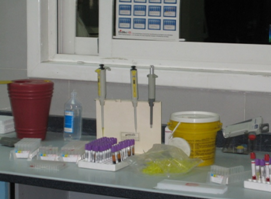 The laboratory diagnosis of brucellosis relies mainly on serologic and culture methods which suffer from lack of standardization of antigen preparations and assay methodologiesBrucellosis is the most common anthropozoonosis worldwide. Human brucellosis is endemic in many regions, including parts of the WHO Eastern Mediterranean Region. Several studies have shown that conventional polymerase chain reaction (PCR) assays could provide a rapid, sensitive and specific testing alternative to serology and culture for the diagnosis of brucellosis.
The laboratory diagnosis of brucellosis relies mainly on serologic and culture methods which suffer from lack of standardization of antigen preparations and assay methodologiesBrucellosis is the most common anthropozoonosis worldwide. Human brucellosis is endemic in many regions, including parts of the WHO Eastern Mediterranean Region. Several studies have shown that conventional polymerase chain reaction (PCR) assays could provide a rapid, sensitive and specific testing alternative to serology and culture for the diagnosis of brucellosis.
Conventional PCR assays have been mainly used in the diagnosis of acute brucellosis, but their value in focal and relapsing cases has not been fully assessed. Researchers found that real-time PCR is more rapid and reportedly more sensitive than conventional PCR. It does not require post amplification handling of PCR products, thereby reducing the risk of laboratory contamination and false-positive results.
In this study, three assays with hybridization probe detection on the LightCycler instrument were developed and compared targeting the 16S-23S internal transcribed spacer region (ITS) and the genes encoding for omp25 and omp31. All assays showed 100% analytical sensitivity and 100% specificity when tested on 28 consecutive clinical isolates of Brucella sp. and 19 clinical isolates of common Gram-negative and Gram-positive bacterial pathogens, respectively.
The ITS assay was the most sensitive with a limit of detection of 2 genome equivalents per PCR reaction. This assay was then clinically validated prospectively with 354 samples (351 whole blood samples and three paraffin-embedded tissues) collected from 340 patients, 24 samples from patients with active brucellosis including two relapsing cases, 31 with treated brucellosis and 299 sero-negative patients where brucellosis was initially suspected.
The clinical sensitivity, specificity, and positive and negative predictive values of the ITS assay were 66.7%, 99.7%, 94.1% and 97.6%, compared with culture at 77%, 100%, 100% and 97.3%, respectively. The difference in sensitivity between culture and ITS-PCR was not statistically significant (P = 0.71). Both relapsing cases were PCR positive. Treated patients were PCR negative. All three assays were positive on tissue samples, but the omp25 and omp31 assays did not detect Brucella sp. DNA in blood samples. Because omp31 is not present in Brucella abortus, these data indicate that the 28 tested isolates are most likely Brucella melitensis. ITS-PCR is rapid and could augment the clinical laboratory diagnosis of human brucellosis.
Citation: Mireille M. Kattar et al. Development and evaluation of real-time polymerase chain reaction assays on whole blood and paraffin-embedded tissues for rapid diagnosis of human brucellosis, Diagnostic microbiology and infectious disease, 2007, 23:32 |PubMed|
This study was technically and financially supported by the WHO Regional Office for the Eastern Mediteranean Special Programme for Research and Training in Tropical Diseases Small Grants Scheme.








